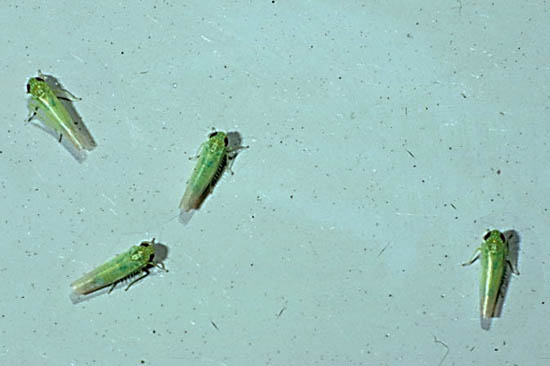Issue 9, June 25, 2018
Potato Leafhopper
Potato leafhoppers (Empoasca fabae) are pests in nurseries and landscapes that cause injury by using their piercing-sucking mouthparts to feed on plant fluids. They feed on oak, maple, red mulberry, red bud, cottonwood, birch, apple, dogwood, hawthorn, wafer ash, euonymus, black locust, and cherry, with red maple being a favorite. They can cause aesthetic injury to leaves and heavy feeding can reduce the annual growth of the plant and the growth of new shoots.

When scouting for potato leafhopper, identify areas that have characteristic leafhopper injury, hopper burn, then try to find and identify the insects in or near those locations. Hopper burn can be identified by looking for curling, stunting and discoloration of leaves. The discoloration can range from a mottled light green color to red and brown. Discoloration may be more apparent on the edges of leaves but can cover the entire leaf. This injury is sometimes confused with herbicide injury like 2, 4-D, or nutrient deficiencies.
Typically the best places to look for potato leafhoppers are on stems and the undersides of leaves. Adults are about 1/8 inch long, wedge-shaped, green insects. When approached, the adults may jump or fly to escape. The nymphs look similar to the adults but lack wings. Potato leafhoppers can be differentiated from other leafhoppers by their movement behavior. All leafhoppers will jump or fly away when you approach, but potato leafhoppers will also walk sideways onto the undersides of leaves.
This species is active throughout the summer so you can continue scouting for leafhoppers and their injury all summer.

Leaf injury is more severe in hot, dry, conditions so our current wet conditions may help plants withstand some injury and treatment may not be needed.
When treatment is needed, carbaryl (Sevin), acetamiprid (TriStar), clothianidin (Arena), thiamethoxam (Meridian), and pyrethroids specifically labeled for potato leafhoppers are effective in controlling leafhopper populations. Because this species is active all summer, repeat treatments of carbaryl and pyrethroids may be needed. Be careful not to apply neonicotinoid insecticides to flowering or actively pollinating plants to ensure pollinator safety. (Sarah Hughson)
Author:
Sarah Hughson